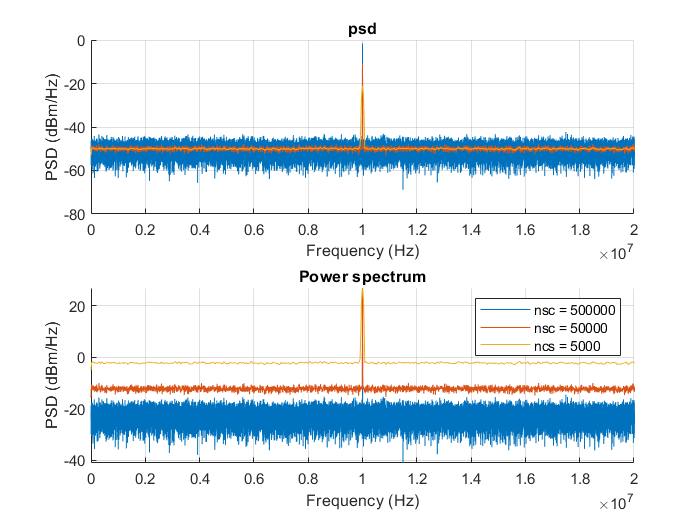The PSD is appropriate if one is interested in consistent noise power levels. If you want consistent signal power levels, you should compute the power spectrum, which uses a different scaling factor. These are the scaling factors Matlab's welch method applies under the hood depending on the method specified.
Denote by $|X|^2$ the frequency averaged Squared Magnitude Spectrum and $w$ the window applied.
- The PSD is: $$\frac{2|X|^2}{f_s \times S_2} \quad S_2 = \sum_{i = 0}^{N - 1} w_i^2$$
- The Power Spectrum is: $$\frac{2|X|^2}{S_1^2} \quad S_1 = \sum_{i = 0}^{N - 1} w_i$$
Add a little noise to your pure tone, and notice how the noise power stays the same but signal power fluctuates when you change nsc with the PSD, and how the opposite is true when using the Power Spectrum:
To replicate:
close all
fs = 20e7;
sine = dsp.SineWave('Amplitude',1,'Frequency',10e6,'SampleRate',fs,'SamplesPerFrame',1000000);
y = sine();
y = y+ randn(length(y),1);
figure(1)
subplot 211
title('psd')
hold on
subplot 212
title('Power spectrum')
hold on
for method = {'psd', 'power'}
for nsc = [500000, 50000, 5000]
nov = floor(nsc/2);
nff = max(256,2^nextpow2(nsc));
[pxx, f] = pwelch(y,hann(nsc),nov,nff,fs, string(method));
pxx = 10*log10(pxx) + 30; % also convert to dBm
if strcmp(string(method), "psd")
subplot 211
else
subplot 212
end
plot(f, pxx);
grid on;
xlim([0 20e6]);
xlabel("Frequency (Hz)");
ylabel("PSD (dBm/Hz)");
end
end
legend('nsc = 500000', 'nsc = 50000', 'nsc = 5000')

